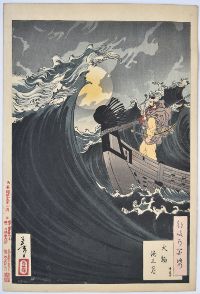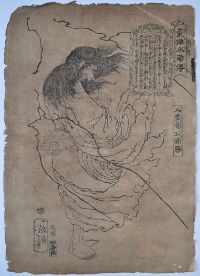Tsukioka YOSHITOSHI (1839-1892)

Click here to view image full size.
The battle of Fujikawa from a set of triptychs Toyotomi Shoshinroku published by Yorozumago, c 1869. The set relates Hideyoshi’s (1537-1598) exploits. From humble origins he became the second unifier of Japan who, after 100 years of war, brought stability and peace.
Fine impression, colour and condition. Full size with extra paper all around. Signed Ikkaisai Yoshitoshi hitsu.
Status: Sold
Tsukioka YOSHITOSHI (1839-1892)
Click here to view image full size.
A triptych from a set of three designs: Buyu setsugekka no uchi, “Snow, Moon and Flowers with Valiant Warriors,” this being “Flower”: Ikutamori ume, “Plum at Ikuta Forest.” The battle of Ichi-no-Tan took place in the forest between the Taira and Minamoto clans. Published by Kiya Sojiro, 2/1867.
Very good impression, colour and condition. Signed Ikkaisai Yoshitoshi hitsu
Status: Sold
Tsukioka YOSHITOSHI (1839-1892)
Click here to view image full size.
The best design from the set Tsuki hyakushi, the “Hundred Phases of the Moon.” The set published between 1885 and 1892 (this being 1886) by Akiyama Buemon. Shows Benkei on the prow of the ship in which Yoshitsune was forced to flee to northern Japan after being attacked by his half-brother Minamoto no Yoritomo. Sailing along the Inland Sea off the coast of Harima Province not far from Kyoto, the ship was struck by a storm in Daimotsu Bay caused by the vengeful ghosts of the Taira warriors Yoshitsune and his men had slain. Benkei pacified the spirits by holding up his string of prayer beads.
Fine impression and colour. Light album backing, otherwise very good condition. Signed Yoshitoshi.
Status: Sold
Tsukioka YOSHITOSHI (1839-1892)
Click here to view image full size.
A unique key-block proof of Happinata Kojo (Chin: Xiang Chong) riding into battle on his horse. This appears to be a proof for an unpublished print for the set Goketsu Suikoden, “Heroes of the Suikoden” published by Ohashi in 1868. Keyes lists just seven designs in this set. Aratame and date seal for 7/1868 and engraver’s seal Hori Wakasa. No publisher’s seal. The kento marks just visible. Browned and creased but commensurate with having survived. Sold “as is.” Signed Ikkaisai Yoshitoshi hitsu.
Status: Sold
Tsukioka YOSHITOSHI (1839-1892)
Click here to view image full size.
A key-block proof of Juunryu Kosonsho (Chin: Kun-sun Sheng) praying with lightning flashing around him. From the set Goketsu Suikoden, “Heroes of the Suikoden” published by Ohashi in 1868. Keyes lists just seven designs in this set. Aratame and date seal for 7/1868 and engraver’s seal Hori Wakasa. Publisher’s seal Ohashi (Daikyodo). One kento mark visible. Browned and creased but commensurate with having survived. Sold “as is.” Signed Ikkaisai Yoshitoshi hitsu.
Status: Sold
Tsukioka YOSHITOSHI (1839-1892)
Click here to view image full size.
A unique key-block proof of Kyubiki Toso-o (Chin: Tao Tsung-Wang) brandishing a sword. This appears to be a proof for an unpublished print for the set Goketsu Suikoden, “Heroes of the Suikoden” published by Ohashi in 1868. Keyes lists just seven designs in this set. Aratame and date seal for 7/1868. The outline for the engraver’s seal printed but the name not inserted. No publisher’s seal. The kento marks evident. Browned and creased but commensurate with having survived. Sold “as is.” Signed Ikkaisai Yoshitoshi hitsu.
Status: Sold
Tsukioka YOSHITOSHI (1839-1892)
Click here to view image full size.
A key-block proof of Botsumenmoku Shotei (Chin: Chiao Ting). From the set Goketsu Suikoden, “Heroes of the Suikoden” published by Ohashi in 1868. Keyes lists just seven designs in this set. Aratame and date seal for 8/1868 and engraver’s seal Hori Wakasa. Publisher’s seal Ohashi (Daikyodo). Kento marks visible. Some creasing but commensurate with having survived. Sold “as is.” Signed Ikkaisai Yoshitoshi hitsu.
Status: Sold
Tsukioka YOSHITOSHI (1839-1892)

Click here to view image full size.
Nise Murasaki inaka Genji, “An Imposter Murasaki and a Rustic Genji.” A triptych based on an involved story written by Ryutei Tanehiko in 1829 and based on the classic 11th century Tale of Genji. Shows Prince Genji with his lover Tasogare at an old temple. A demon appears pretending to be Genji’s wife Futaba, but in reality is Tasogare’s mother, Shinonome. Genji, discovering her true identity, reveals that his affair with her daughter is only in order to regain the family sword. Tasogare and her mother commit suicide due to the great shame. Published by Akiyama Buemon in 1884.
Fine impression, colour and condition. Signed Yoshitoshi sha.
Status: Sold
Tsukioka YOSHITOSHI (1839-1892)

Click here to view image full size.
Saimyoji Tokiyori Nyudo in the snow from a set of 51 prints Dai Nippon meisho kagami, “A Mirror of Famous Commanders of Great Japan.” The set was published by Ebisuya Shoshichi (the first 11 prints) and Funazu Chujiro between 1878-1882. Tokiyori became Regent (Shikken) in 1246. In 1256 he took the tonsure and was reputed to travel the country incognito to view and better understand the living conditions of the people. Published by Funazu Chujiro in 1878.
Fine, early impression. This is the first state. The snow block was recut on later editions. Fine colour. Light album backing, otherwise fine condition. Signed Oju Yoshitoshi hitsu
Status: Sold
Tsukioka YOSHITOSHI (1839-1892)

Click here to view image full size.
The serpent Tamichi attacking his enemies from a set of 51 prints Dai Nippon meisho kagami, “A Mirror of Famous Commanders of Great Japan.” The set was published by Ebisuya Shoshichi (the first 11 prints) and Funazu Chujiro between 1878-1882. Like Abe no Hirafu, Tamichi was involved in the subjugation of the Emishi. He was killed by a poisoned arrow but was reincarnated as a giant snake to finally overcome his enemies. Published by Funazu Chujiro in 1880.
Fine, early impression with mica on the snake. Fine colour. Light album backing, otherwise fine condition. Signed Oju Yoshitoshi hitsu.
Status: Sold
Tsukioka YOSHITOSHI (1839-1892)

Click here to view image full size.
A vertical diptych showing Taira no Koremochi discovering that a princess is, in reality, a demon. Taira Koremochi Togakushiyama kijo taiji no zu. The story relates how, while maple viewing on Mt. Togakushi in Shinano, Taira no Koremochi comes across a princess and her attendants. He joins them eating and drinking and finally falls into a deep sleep. He dreams that the princess is in fact a kijo (a young woman turned into an oni) and that she is intent on killing him. He awakes to see her true appearance reflected in the water of a nearby stream and kills her. Published by Matsui Eikichi, 1887. It was republished later by Hasegawa.
Very fine impression and colour. Perfect condition with ample room for joining of two sheets and full margin on left and top – which these designs must have. Signed Oju Yoshitoshi.
Status: Sold
Tsukioka YOSHITOSHI (1839-1892)

Click here to view image full size.
A triptych from a set of ten: Dai Nippon shiryaku zue, “Short Illustrated History of Great Japan.” Each print is in the form of an unrolled makimono. This design shows the third son of the twelfth century Emperor Keiko, Yamato Takeru no mikoto (Wo-usu). His father was constantly sending him on dangerous missions making him suspect that he wished his death. One such journey was to the Emishi in northeast Japan. On complaining about this to his high-priestess aunt, Yamato-hime, she gave him the famous sword Ame no murakumo no hoken to aid him. On his arrival, the ruler of the Emishi lured him onto open grassland which he set on fire. Wo-usu used his sword to cut the grass, evade death, and start new fires to kill his enemy. Published by Kobayashi 1880. A fine design.
Fine impression of first edition. Fine colour. Slight album backing, otherwise very good condition. Signed Taiso Yoshitoshi.
Status: Sold
Tsukioka YOSHITOSHI (1839-1892)

Click here to view image full size.
A triptych from a set of ten: Dai Nippon shiryaku zue, “Short Illustrated History of Great Japan.” Each print is in the form of an unrolled makimono. This design shows the twenty-first Emperor Yuryaku-Tenno (457-479) out following his favourite diversion – hunting. The story relates how during 461 on Mount Katsuragi a large boar attacked him. He ordered his aid to shoot it but the man ran away, whereupon the Emperor kicked the boar onto its back and killed it. Published by Tsunashima 1879.
Fine impression of first edition. Fine colour. Slight album backing, otherwise very good condition. Signed Taiso Yoshitoshi.
Status: Sold
Tsukioka YOSHITOSHI (1839-1892)
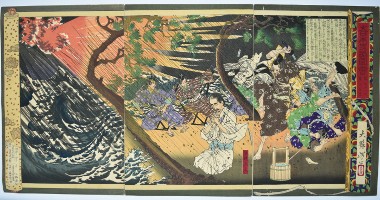
Click here to view image full size.
A triptych from a set of ten: Dai Nippon shiryaku zue, “Short Illustrated History of Great Japan.” Each print is in the form of an unrolled makimono. This design shows the attempted execution of Nichiren during the reign of the ninetieth Emperor Kameyama (1249-1305). Details vary but essentially the attempt was made on the beach at Tatsunokuchi, Kamakura in 9/1271. As the party were passing the shrine of the god Hachiman, Nichiren gave vent to his anger at being unprotected and called on various Buddhist deities. A luminous object shot across the sky and a fierce wind materialized. The soldiers fell to the ground and called off the execution. Published by Morimoto 1879. A fine design.
Fine impression of first edition. Fine colour. Slight album backing, otherwise very good condition. Signed Taiso Yoshitoshi.
Status: Sold
Tsukioka YOSHITOSHI (1839-1892)

Click here to view image full size.
A triptych from a set of ten: Dai Nippon shiryaku zue, “Short Illustrated History of Great Japan.” Each print is in the form of an unrolled makimono. This design shows the great battle of Dannoura in the Shimonoseki Strait off the southern tip of Honshu on April 25th, 1185. The engagement took place in the reign of the Emperor Antoku (who drowned in the battle, 1178-1185). The protagonists were the Minamoto clan (Genji) led by Minamoto no Yoshitsune and the Taira clan (Heike). The episode shown here is where Yoshitsune escapes the Heike general Noto no kami Noritsune by making the eight-boat leap. Published by Morimoto 1880.
Fine impression of first edition. Fine colour. Slight album backing, otherwise very good condition. Signed Taiso Yoshitoshi.
Status: Sold
Tsukioka YOSHITOSHI (1839-1892)

Click here to view image full size.
A triptych from a set Buyu setsugekka, “Heroes for the Snow, Moon and Flowers,” this being Gojo no tsuki, “Moon Over Gojo [Bridge].” Published by Isaya Kanekichi c 1867. A popular subject for artists it tells of the battle between the young Yoshitsune and the warrior monk Benkei who had secured the bridge and fought each samurai wanting to cross in order to steal their sword. The 1000th was Yoshitsune who defeats Benkei and secures his loyalty for the ensuing years. Yoshitsune was taught martial arts by tengu in the forests outside Kyoto as a child and they are seen here aiding and abetting him in his duel.
Fine impression, colour and condition. Full size with added mica at top. Signed Ikkaisai Yoshitoshi hitsu.
Status: Sold
Tsukioka YOSHITOSHI (1839-1892)
Click here to view image full size.
One of Yoshitoshi’s finest designs: Gikeiki Gojobashi no zu. The fight between Ushiwaka and Benkei on Gojo Bridge, Kyoto. The story relates how Benkei only needs one more blade to add to the 999 he has wrenched from samurai attempting to cross the bridge in order to fashion an invincible weapon. Benkei loses the fight and becomes Yoshitsune’s loyal retainer. Published 1881 by Morimoto Junzaburo.
Fine impression and colour. Very slight trimming, otherwise fine condition. Signed Taiso Yoshitoshi ga.
Status: Sold
Tsukioka YOSHITOSHI (1839-1892)
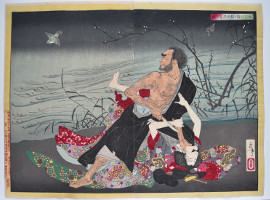
Click here to view image full size.
A diptych showing the Buddhist priest Dainin about to kill the girl Umegae. Daininbo Umegae o satsugai no zu, “Picture of the Priest Dainin Killing the Girl Umegae.” From a set of prints Shinsen azuma nishiki-e, “New Selection of Eastern Brocade Pictures.” The priest momentarily looks up at a passing cuckoo. The set published by Tsunashima Kamekichi between 1885 and 1889, this being 1886.
Very fine impression of the first edition. Fine colour and condition. Signed Yoshitoshi.
Status: Sold
Tsukioka YOSHITOSHI (1839-1892)

Click here to view image full size.
A vertical triptych showing Taira no Kiyomori (1118-1181) watching Akugenta Yoshihira (“Wicked Genta of Kamakura”) (1140-1160) become the Thunder God and strike Namba no Jiro (1141-1160) down with a thunderbolt. An exceptional design of a subject that produced some excellent interpretations by Kuniyoshi and his pupils. Kiyomori nyudo Nunobiki no taki yuran Akugenta Yoshihira no rei Namba Jiro o utsu. The story originates from the Heiji Monogatari and relates how Minamoto no Yoshihira was defeated in the Heiji Rebellion of 1160 and decapitated by Namba no Saburo Tsunefusa, a retainer of Taira no Kiyomori. He pledges to return and kill Namba with a thunderbolt which he succeeds in doing in 1168 at the Nunobiki Waterfall. There is an alternative version of events that gives the decapitation and subsequent revenge killing as all taking place at the Nunobiki Waterfall. Published by Kinkyo (Omiya Kyujiro) in 1868. Of the utmost rarity: There might have been impressions circulating privately, but I have never seen an example for sale since I started dealing: Perhaps few impressions were printed, but the vertical triptych format is not conducive to it surviving intact. Another impression is in the MET, acc. no. 2007.49.307a-c. Possibly Yoshitoshi’s masterpiece.
Fine impression and colour. Some slight trimming. Oxidation and minor horizontal crease at bottom of centre sheet evident au verso, but otherwise in very good condition. Signed Tsukioka Yoshitoshi hitsu.
Status: Sold
Tsukioka YOSHITOSHI (1839-1892)

Click here to view image full size.
Shows Wakashima Gonemon diving into a whirlpool in an attempt to fasten a rope to the old dragon-headed temple bell and haul it up from the bed of the Sumida River. The story relates how the Dragon King thwarted his attempt by cutting the rope. From a set Azuma nishiki Ukiyo Kodan, “Rough Tales of the Floating World Told on Eastern Brocades.” Kodan (traditional storytelling) raconteurs narrated Japanese folk stories, sometimes accompanying themselves with wooden blocks clapped together or a fan giving rhythm. Having been popular from around 1700 (and known as Koshaku), these performances gained renewed popularity in the 1850s with the classic standards augmented by contemporary stories of heroes and vigilantes. Here, the storyteller Hogyusha Torin, narrates a story by Kanagaki Robun, the text seen in the open book top left. The best design from the set. Published by seven different publishers (here: Masudaya Ginjiro) between 1867-1868 (here: 1867).
Fine impression, colour and condition. Signed Ikkaisai Yoshitoshi hitsu.
Status: Sold
Tsukioka YOSHITOSHI (1839-1892)
Click here to view image full size.
The ronin Okuda Sadaemon Fujiwara Yukitaka ( number 42 ) from Seichu gishinden, “Tales of True Loyalty.” From a rare uncompleted set of the 47 Ronin published 6/1868 by Masudaya. Thirteen designs extant. It has been suggested that the set was completed but that the others are not known based on the fact that two of the prints are numbered 3 and 46. An error as artists did not commence and progress from number 1. Artists chose at random which numbers from a set to start with. Well known examples being Hiroshige’s Tokaido and Kisokaido.
Very good impression and colour. Light album backing. Signed Ikkaisai Yoshitoshi hitsu.
Status: Sold
Tsukioka YOSHITOSHI (1839-1892)

Click here to view image full size.
A triptych showing Saigo Takamori about to commit seppuku in a boat. Next to him are Murata Shinhachito and Kirino Yoshiaki. Saigo Takamori seppuku no zu. The “last true samurai,” he was instrumental in overthrowing the Tokugawa Shogunate. However, he had a falling out with the new Meiji government and returned to his native Satsuma in 1877 and led the so-called Satsuma Rebellion. This failed after seven months and the three in the boat were the last survivors of the rebellion. Published by Okura Magohei, 1877.
Very fine impression. Fine colour. Original album backing, otherwise good condition. Signed Oju Taiso Yoshitoshi.
Status: Sold
Tsukioka YOSHITOSHI (1839-1892)
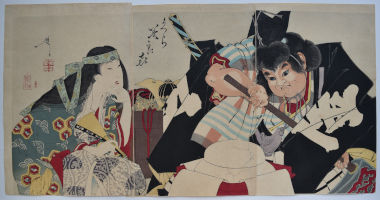
Click here to view image full size.
A triptych showing Yamauba on the left and Kintaro about to wield a large axe to break a large Kaga mimochi, mirror rice cake. This is a traditional Shinto rite in January. January 11th is also the day the wealthy opened their storehouses to air their precious possessions (Kurabiraki). Published by Akiyama Buemon 1891.
Very fine impression with extensive burnishing. Fine colour and condition. Signed Yoshitoshi.
Status: Sold
Tsukioka YOSHITOSHI (1839-1892)

Click here to view image full size.
Haso no tsuki, “Moon Through a Crumbling Window” from the set Tsuki hyakushi, the “Hundred Phases of the Moon.” The set published between 1885 and 1892 (this being 1886) by Akiyama Buemon. Shows Bodhidharma (Jap: Daruma), founder of Zen Buddhism, meditating in a cave for nine years after being refused entry to the Shaolin Monastery. He cut off his eyelids in anger after falling asleep two years into the meditation, and tea plants grew where they fell.
Fine impression with strong woodgrain showing in the sky and wall. The set was popular and many editions were printed and many late impressions exist. Great care was taken with the cutting of the blocks on this set and only early impressions do them justice. Fine colour and condition. An impression that has not been in an album. Full margins. Signed Yoshitoshi.
Status: Sold
Tsukioka YOSHITOSHI (1839-1892)

Click here to view image full size.
Faith in the Third-day Moon from the set Tsuki hyakushi, the “Hundred Phases of the Moon.” The set published between 1885 and 1892 (this being 1886) by Akiyama Buemon. Shows the standing figure of the samurai Yamanaka Shikanosuke Yukimori. The moon appears both as a half crescent on his helmet, and also on his kamayari, “sickle spear.” The crescent moon was considered a lucky emblem (mikazuki) and Yukimori believed it would bring him good luck in battle
Very fine impression of the earliest printing with beautiful gradation around the figure – often missing on late editions. The set was popular and many editions were printed and many late impressions exist. Great care was taken with the cutting of the blocks on this set and only early impressions do them justice. Fine colour. Light backing and slight trimming at left, otherwise fine condition. Signed Yoshitoshi.
Status: Sold
Tsukioka YOSHITOSHI (1839-1892)

Click here to view image full size.
Saito no Oniwakamuru from the set Ikkai zuihitsu, “A Miscellany by Ikkai.” (This being an early name of Yoshitoshi’s.) The young Saito Musashibo Benkei was given the moniker Oniwakamuru “Devil Child” because of his feats of strength and general behaviour. The episode depicted here, which was a popular theme for artists, shows the young Oniwakamaru battling a giant carp at the Bishamon Waterfall, where he has gone looking for his mother, Ohaya. On killing the carp, he discovers it has eaten his mother. A set published by Masadaya Heikichi, 1872-3 (this being 1872). Even amongst Yoshitoshi’s best work, this is an outstanding design.
Very fine impression of the first edition. Fine colour and condition. Signed Ikkaisai Yoshitoshi hitsu.
Status: Sold
Tsukioka YOSHITOSHI (1839-1892)

Click here to view image full size.
Shows the famous Heron Maiden. There are different versions of this story but the most common tells how a young man finds an injured heron. He nurses it back to health and releases it. Some time later a beautiful young woman appears in his village. He falls in love and they marry. She makes fine brocade which they sell, but she does not allow him to see her making it. Tempted , he secretly views her only to discover she is the heron. This is the end of their marriage and the heron flies away. From the set Shingata sanjurokkaisen, “New Forms of Thirty-six Ghosts,” subtitle: Sagi-musume. The set published by Sasaki between 1889-1892 (this being 1889). This is the first edition.
Very fine impression, colour and condition. Signed Yoshitoshi.
Status: Sold
Tsukioka YOSHITOSHI (1839-1892)

Click here to view image full size.
Musashino no tsuki, “The Moon on Musashi Plain” from the set Tsuki hyakushi, the “Hundred Phases of the Moon.” The set published between 1885 and 1892 (this being 1892) by Akiyama Buemon. One of the three best designs from the set and one that relies most on the printer’s art – using extensive bokashi. The fox was capable of transmogrifying into human form and vice versa and was popular in Japanese folklore.
Very fine impression with beautiful gradation of the earliest printings on the grasses around the fox. (See Beauty & Violence, 1992, 54.97, p. 75 for an example of the more prosaic later printing.) The set was popular and many editions were printed and many late impressions exist. Great care was taken with the cutting of the blocks on this set and only early impressions do them justice. Fine colour and condition. An impression that has not been in an album. Full margins. Signed Yoshitoshi.
Status: Sold
Tsukioka YOSHITOSHI (1839-1892)

Click here to view image full size.
A fox priest from the set Tsuki hyakushi, the “Hundred Phases of the Moon.” The set published between 1885 and 1892 (this being 1886) by Akiyama Buemon. Based on the Kyogen farce Konkai, “A Foxe’s Cry” which tells of a hunter who is lectured on trapping foxes by his uncle, a priest. On his way home his uncle turns into his true form, a fox, and is snared in a trap. Yoshitoshi’s design shows the uncle transmogrifying into a fox. One of the best designs from the set.
Fine impression and colour from an early printing. The set was popular and many editions were printed and many late impressions exist. Great care was taken with the cutting of the blocks on this set and only early impressions do them justice. Fine colour and condition. An impression that has not been in an album. Full margins. Signed Yoshitoshi.
Status: Sold
Tsukioka YOSHITOSHI (1839-1892)

Click here to view image full size.
A triptych Gikeiki Gojobashi no zu, “Gojo Bridge in the Chronicles of Yoshitsune.” Shows Musashi-bo Benkei of herculean strength subdued by the young Onzoshi Ushiwaka Maru (Yoshitsune) on Gojo Bridge.The story relates how Benkei (1155-1189) wandered around Kyoto with the intention of relieving 1000 samurai of their swords. One night, with one more sword to go, he saw Yoshitsune playing a flute and wearing a golden sword at the Gojotenjin Shrine. They agreed to fight on Gojo Bridge in southern Kyoto. However, Yoshitsune was too agile for Benkei and had been educated in the secrets of fighting by the tengu. Following Yoshitsune’s victory Benkei became Yoshitsune’s retainer. Published by Morimoto Junzaburo, 1881. One of Yoshitoshi’s best designs.
Very good impression and colour. Later editions lack the black outline around the moon and have clouds added. (Interestingly, a feature usually found on the earliest states of prints, but in this case the reverse.) Very good condition. Signed Taiso Yoshitoshi ga.
Status: Sold
Tsukioka YOSHITOSHI (1839-1892)

Click here to view image full size.
A triptych showing the Japanese Buddhist deity Fudo Myo-o, one of the five “Kings of Wisdom,” above the novitiate priest Yuten Shonin (1637-1718) about to consume the sword of wisdom thereby gaining supernatural wisdom and enlightenment. (Often miscatalogued as threatening him.) On the right is the goddess of mercy, Kannon. The scene is set in the Zojoji Temple where Shonin goes on to become the Abbot. Published by Akiyama Buemon, 1885.
Fine impression with the publisher’s details intact in the left border of last sheet – often trimmed off. Fine colour and condition. Signed Yoshitoshi.
Status: Sold
Tsukioka YOSHITOSHI (1839-1892)

Click here to view image full size.
A vertical diptych Shunkan sozu Kikaigashima ni oite tamatama Yasuyori no shamen sembo kito no zu. Shows Shunkan watching a boat sail away from Kikai Island with his pardoned compatriots. Shunkan, the abbot of the Zen temple Hoshoji in Kyoto, was exiled to the barren island of Kikaigashima together with two confederates in 1177 for conspiring against Taira no Kiyomori. The following year Kiyomori pardons political prisoners but omits Shunkan. He is seen here beseeching the boat with his two conspirators to return. Published by Matsui 1886.
Fine impression of first state. Fine colour with splashed gofun and blind-printing. Fine condition with ample room for joining the two sheets. Signed Yoshitoshi.
Status: Sold
Tsukioka YOSHITOSHI (1839-1892)

Click here to view image full size.
“Flood” from a series Seiu kandankei, “A Barometer of Emotions.” Shows Nakamura Shikan III as Abe Bungo no Kami riding his horse through waves. Published by Okura Magobei 1876-77 (this being 1876). A rare set with some striking designs comparing actors in theatrical roles with meteorological phenomena.
Fine impression and colour. Slight trimming, otherwise fine condition. Signed Oju Yoshitoshi hitsu.
Status: Sold
Tsukioka YOSHITOSHI (1839-1892)
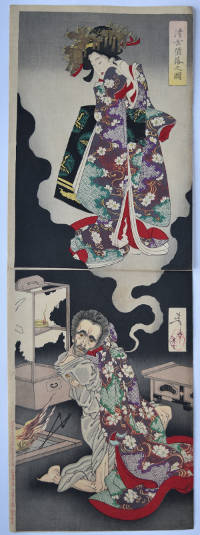
Click here to view image full size.
A vertical diptych Seigen daraku no zu showing the priest Seigen of the Kiyomizudera Temple in Kyoto and the beautiful Sakura-hime (Princess Sakura). Several versions of the story exist. In one, Sakura-hime is Seigen’s long-deceased lover reincarnated as a young priest called Shiragiku. In another, Shiragiku is the dead lover reborn as Sakura-hime. The main thrust of the tale is that Seigen’s lust gets the better of him resulting in his removal from the temple. It was the basis of the play Sakura Hime azuma bunsho premiered 3/1817. This is the rare first state of the first edition published by Matsui Eikichi, 1889. It was republished by Hasegawa Tsunejiro in 1889 with the publisher and date in left border and on most impressions a seal at top left reading “Reproduction not allowed.”
Very fine impression with hand-applied colour to the eyes, teeth and nails with gum overlay to eyes on Seigen. Fine colour. Minor edge wear to right, otherwise fine condition. Ample room for joining. Signed Yoshitoshi.
Status: Sold
New Tsukioka YOSHITOSHI (1839-1892)

Click here to view image full size.
A triptych , Shinyo rokkaisen, “Six New Monsters” showing Taira no Kiyomori (1118-1181) and his lover on the engawa of the palace confronted by a multitude of snow covered skulls and skeletons in the garden. Towards the end of his life, Kiyomori, the head of the Taira Clan, was obsessed with and hallucinated that his vanquished enemies – on his quest for power and authority – had come back for retribution. Published by Funazu, 1882.
Very fine impression. Fine colour. Sheets attached, otherwise fine condition. Signed Oju Yoshitoshi ga.
Status: Sold
Tsukioka YOSHITOSHI (1839-1892)

Click here to view image full size.
Abe no Hirafu fighting a giant bear in the snow from a set of 51 prints Dai Nippon meisho kagami, “A Mirror of Famous Commanders of Great Japan.” The set was published by Ebisuya Shoshichi (the first 11 prints) and Funazu Chujiro between 1878-1882. Hirafu was a general for the Empress Saimei. On his return from a mission to the Emishi in northeastern Japan, where he signed a peace agreement , he presented the Empress with two live bears and seventy bear hides. Published by Funazu Chujiro in 1880.
Fine, early impression with splashed gofun (only on the earliest states). Fine colour. Light album backing, otherwise fine condition. Signed Oju Yoshitoshi hitsu.
Status: Sold
Tsukioka YOSHITOSHI (1839-1892)

Click here to view image full size.
Yatsunada attacking Saohime’s brother’s castle from a set of 51 prints Dai Nippon meisho kagami, “A Mirror of Famous Commanders of Great Japan.” The set was published by Ebisuya Shoshichi (the first 11 prints) and Funazu Chujiro between 1878-1882. Saohime had conspired with her elder brother Saohikoto to murder the emperor but she abandoned their plan at the last moment. She is seen escaping the conflagration. Published by Funazu Chujiro in 1880.
Fine, early impression. Fine colour. Light album backing, otherwise fine condition. Signed Oju Yoshitoshi hitsu.
Status: Sold
Tsukioka YOSHITOSHI (1812-1866)

Click here to view image full size.
The actor Ichikawa Kodanji IV as Torii Matasuke clenching a sword between his teeth in pouring rain. From the play Kagamiyama gonichi no Iwafuji performed at the Ichimura Theatre, 3/1860. The plot centres around Lord Taga who is disloyal to his wife Lady Ume with Oryu. One of Taga’s retainers, Motome, advises him against his actions and is dismissed. Meanwhile Oryu and her husband plan to take over Taga’s domain so a plot is hatched to kill her. However, Motome’s faithful servant, Matasuke, murders Lady Ume by mistake. The design shows Matasuke just prior to his mistake. Published by Kaku-Kin (Kakumotoya Kinjiro), 1860.
Fine impression and colour. Some minute restored binding holes and very slight trimming on right, otherwise very good condition. Signed Ikkaisai Yoshitoshi ga.
Status: Sold
Tsukioka YOSHITOSHI (1812-1866)

Click here to view image full size.
A diptych showing the strong woman Oiko of Takashima. The story tells how the wrestler Saeki Urinaga spies her one day fetching water from the river. He lecherously reaches for her only to have his arm pinned down by her as she nonchalantly carries on walking. She leads him home for a wrestling match. From a set Shinsen azuma nishikie, published by Tsunashima between 1885 and 1889 (this being 1889).
Fine impression and colour. Light album backing, otherwise very good condition. Signed Yoshitoshi.
Status: Sold
Tsukioka YOSHITOSHI (1839-1892)

Click here to view image full size.
The best design from the set Tsuki hyakushi, the “Hundred Phases of the Moon.” The set published between 1885 and 1892 (this being 1886) by Akiyama Buemon. Benkei against a full moon. In 1185 Yoshitsune, attacked by his half-brother Minamoto no Yoritomo, was forced to flee to northern Japan by ship. Sailing along the Inland Sea off the coast of Harima Province not far from Kyoto, the ship was struck by a storm in Daimotsu Bay caused by the vengeful ghosts of the Taira warriors Yoshitsune and his men had slain. Benkei pacified the spirits in the prow of the boat by holding up his string of prayer beads.
Fine impression. (A good guide to the quality of impression is to look at the outline of Benkei’s face: This fine line started to break down early on. The set was popular and many editions were printed and many late impressions exist. Great care was taken with the cutting of the blocks on this set and only early impressions do them justice. There should be subtle gradation in the sky and the title cartouche has hardly any colour.) Fine colour and condition. An impression that has not been in an album. Full margins. Signed Yoshitoshi.
Status: Sold

